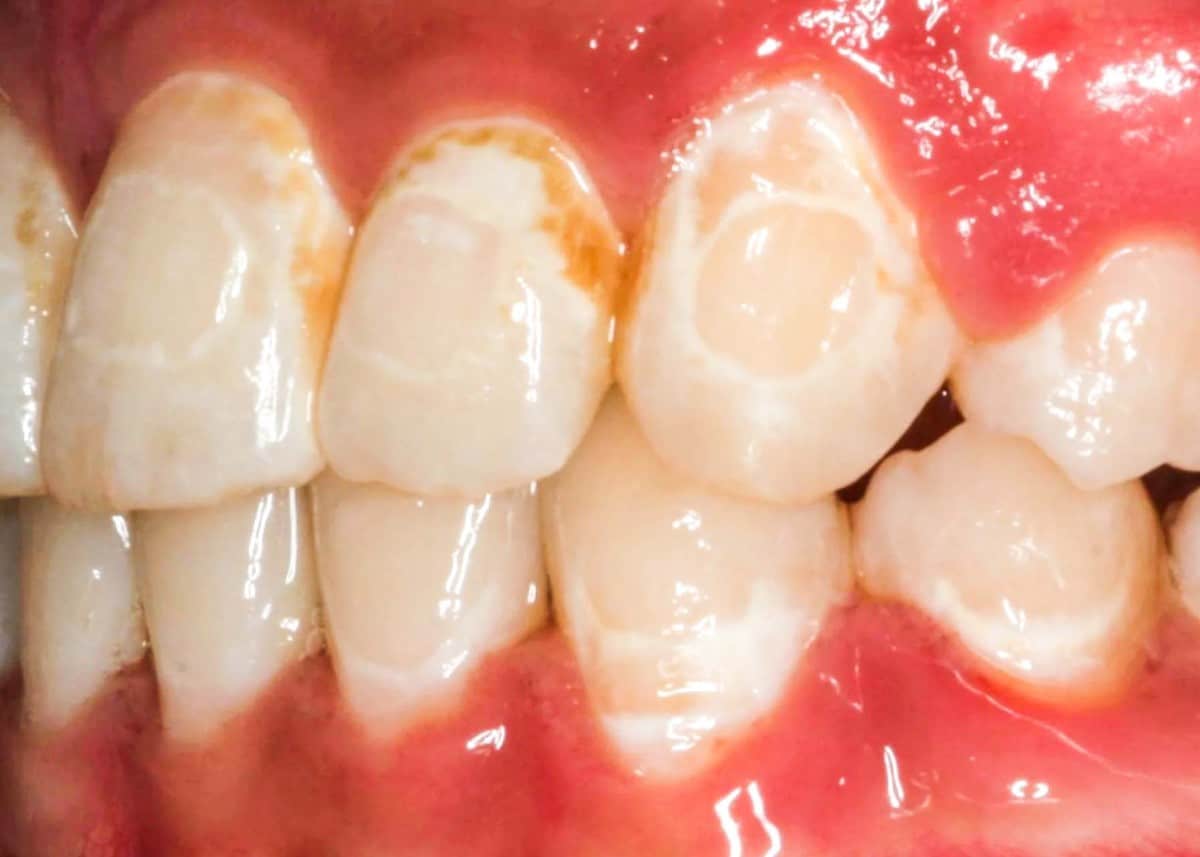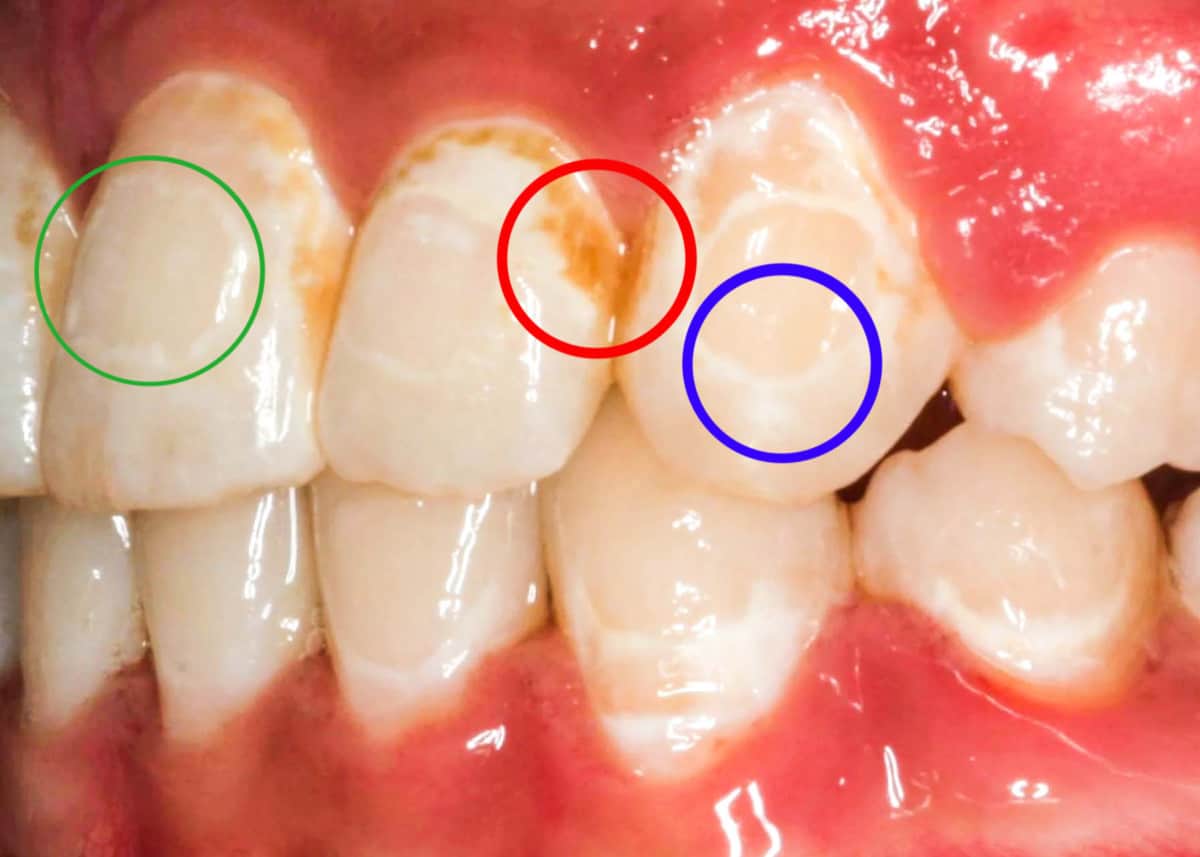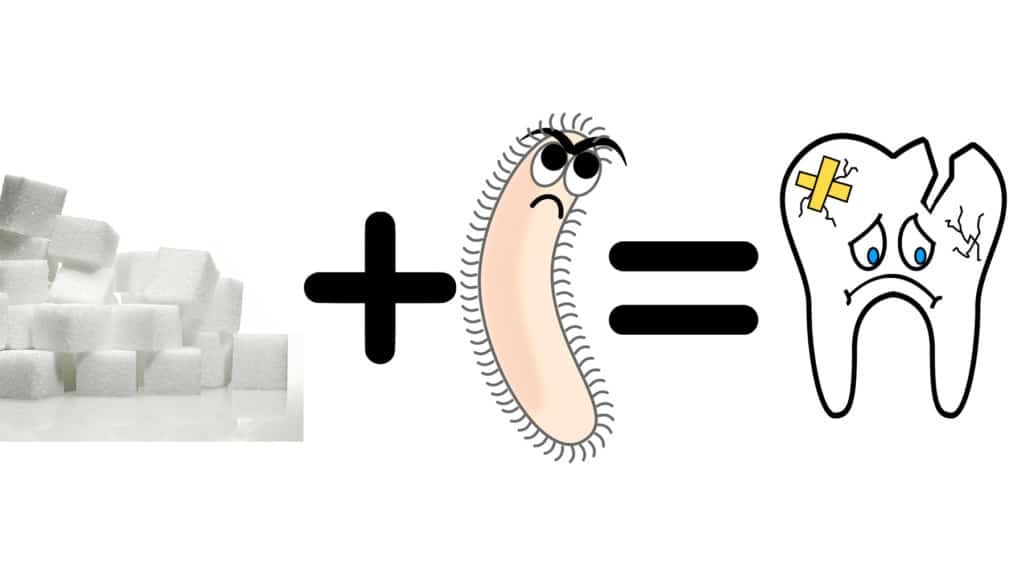
It breaks my dental hygiene heart seeing white spots on my patient’s teeth while having braces or after getting them off. I always talk about white spots with my patients who are just about to get braces or already have them, and they often ask me if the white spots are permanent.
White spots on teeth from braces can be permanent if not treated in time. White spots occur when the tooth is demineralized by acid-producing bacteria, food and drink. If demineralization continues and is not caught right away, the tooth can be permanently damaged and cause permanent white spots
In this post, I go over everything you need to know regarding white spots, including how common they are, their causes, how long they take to go away, how to prevent white spots, and how to tell you will have white spots after getting your braces off!
I want to point out that white spots that have been apart of the tooth structure since formation/erupting in the mouth are much different than the white spots formed during orthodontic treatment and are not related to the breakdown of the tooth surface due to an acidic environment.
Are white spots after braces permanent?
Once enough damage has occurred, white spots become permanent. There are different classifications and varying degrees of severity of white spots from braces. The very first stage of white spots is when the tooth surface starts to demineralize.
In my dental chair;
The way I describe this first stage of demineralization to my patients is I ask them to picture their tooth surface as a brick wall. As the bacteria produce acid, and we consume acidic food and drink, we slowly start losing individual bricks in the wall, but the wall is still intact and standing upright.
If we don’t fix and replace those individual bricks right away (with brushing, floss, and fluoride treatments), we end up losing a whole section of the wall and it needs a much more complex repair.
This very first stage can be reversed, and white spots will not become permanent.
Early diagnosis and treatment of white spots are crucial to reverse them and prevent permanent damage. In the first stages of white spots forming, fluoride treatments can remineralize the tooth and prevent the damage from penetrating deeper into the tooth and becoming permanent/harder to treat.
Read Now: Cosmetic or Medical? Reasons Why Dental Braces Are Needed
As the severity of the white spots increases, they become permanent. However, this doesn’t mean that we can’t diminish their appearance.
The ways to minimize the appearance of white spots can be found further down in this post.
Pictures of stained teeth after braces; white spot variations
White spots on the teeth from braces can have many different appearances depending on severity. Immature white spots will just look like chalky white spots on the teeth. As the white spots progress and the damage to the tooth surface intensifies, actual tooth structure will be lost, and the tooth can become pitted and decay. This can result in more brown staining.
Below you can find a picture that includes varying severity of white spots.

How common are white spots after braces?
White spots occur in about 73% of people who have braces that are permanently fixed to the teeth. The prevalence of white spots is higher with fixed orthodontic due to the increased difficulty to clean around the brackets, more surface area for bacteria to thrive on, and food gets caught easily.
This damage can be 100% prevented with proper home care, fluoride exposure, and dental hygiene care.
If you or someone you care for is going through orthodontic treatment, please ensure regular dental hygiene appointments are maintained. While going through orthodontic treatment, decay and gum disease are more prevalent. We dental hygienists can catch things early enough they can be reversed, give insight into what is going on in the mouth, and give personalized advice.
Read Now: Braces: What Age Is Too Late? Dental Hygienist Explains!
What Causes White Spots after Braces? Hygienist Explains!
White spots on teeth after braces are caused by demineralization of the tooth surface by acid-producing bacteria and food and drink high in sugar/acid, which cause permanent damage. White spots are visible on the teeth because light refracts differently from damaged tooth structure.
The tooth becomes damaged when oral pH is below 5.5 pH. Acid-producing bacteria, food and drink high in sugars, acids, and carbohydrates, all reduce oral pH.
Increased acid in the mouth is primarily caused by poor oral hygiene habits, so the plaque sits on the teeth for too long, and the bacteria feed on the food stuck in our mouth and continue to reproduce and secrete acid.

It’s not only what we eat or when we eat, time spent eating/drinking plays a huge role in the demineralization of the tooth surface.
If you are sipping on a nice vanilla latte (this was the cause of a massive cavity I got while in dental hygiene school), it is best to drink it all in one go, instead of sipping on it over 2 hours (like I did when I was studying).
Each time you expose your mouth to sugar, it lowers the pH level of our mouth, and it takes our saliva about 30 minutes to buffer out all the sugar/acid.
Let’s say it took you 20 minutes to drink that vanilla latte. After your last sip, it will take 30 minutes for your saliva to go to work. So in total, your mouth would be in a state of low pH for 50 minutes.
Now let’s say you sip on that vanilla latte for 2 hours, after your last sip it will take 30 minutes for your saliva to get to work. So in total, your mouth would be in a state of low pH for 2 hours and 30 minutes. This extra time contributes to more demineralization and damage to the tooth.
Read now: What To Do if Teeth Shift Back After Braces? How To Fix
Now if you avoid brushing your teeth and the bacteria count in your mouth increases substantially, it can make the mouth be in a chronic state of low pH. In a chronic state of low pH, your teeth cannot catch a break, and demineralization is a continuous cycle, causing permanent damage to the tooth structure, white spots, cavities, and on another note, gum disease.
How long does it take for white spots on teeth to go away?
The length of time it takes for white spots to go away is reliant on how severe they are, what treatments are done, and how often they are done. For very mild cases of white spots, remineralization with fluoride can take a day to a couple of weeks for them to go away.
As I have mentioned earlier in this post, any white spot lesions that have passed the first mild stage will become permanent. Because of the permanent damage to the tooth surface, the light will continue to refract from the white spots differently than the healthy tooth structure adjacent.
For white spots, the following treatments are done to reduce white spot appearance.
- Fluoride varnish application
- White spot lesion infilatration treatment with ICON-Etch gel (15% HCl) system or a resin
- Teeth whitening
- Micoabrasion
The white spots appearance can be reduced by the above therapies but should not be a reliable solution. Preventing white spots from occurring in the first place is the most important thing that can be done!
How you can prevent white spots after braces!
Prevention starts the day you get your braces put on your teeth. Proper oral hygiene techniques are crucial to prevent white spots.
When I got my braces for the first time, part of the appointment was dedicated to educating me on how to keep my mouth clean and healthy and why it is so important and preventing white spots, cavities, and gum disease.
Read Now: Waterpik vs Floss for Braces. Dental Hygienist’s Guide
Now that I am a dental hygienist, I appreciate how good my orthodontist was. I get so discouraged when I have patients who have gotten their braces on and are not properly educated on how and why it is important to clean around them, and they come to see me 6 months later and their mouth is not in good shape and white spots have already started.
It is not up to the patient to just know these things. Proper oral hygiene education needs to be done with everyone, regardless of how much they already know.
As dental professionals, we need to be accountable and provide all of our patients with all of the information for them to use to keep their mouths healthy as can be.
The following list is the best way to prevent white spots from occurring;
- Using a fluoridated toothpaste
- especially one that works best for preventing acid erosion – Sensodyne ProNamel
 (this is the one that I use daily)
(this is the one that I use daily) - or using a higher fluoride contentration toothpaste. I recommend the Colgate prevident 5000 to my patients who are in need for extra flouride.
- very important to clean in between the teeth first, then brush for 2 minutes with only a pea sized amount of toothpaste, and after brushing only spit! Do not rinse/eat/drink for at least 30 minutes after so the flouride can have its maximum effect on the teeth.
- especially one that works best for preventing acid erosion – Sensodyne ProNamel
- Brushing 2 times a day for 2 minutes and flossing/cleaning between the teeth at least 4 times a week
- Using xylitol mints/lozenge after eating or drinking.
- Orthodontist uses glue that contains fluoride
- Oral flora probiotics
- Chlorhxidine rinse/varnish (this is medical grade and needs to be prescribed) and will only be used in select cases.
You can check out my Orthodontic Resource page where I put together a page explaining all the products that I used, and I recommend them to both my family and patients who are going through orthodontic treatment.
where I put together a page explaining all the products that I used, and I recommend them to both my family and patients who are going through orthodontic treatment.
And PLEASE if you have any questions, please ask your dental professional as they can see you in person and give you advice that is 100% for you.
In some circumstances, if oral hygiene is poor enough and the health of the teeth and gums are in peril, the orthodontist will take off the braces prematurely.
How to tell if you will have white spots after braces!
You can tell if you have white spots after/during braces by checking the tooth colour in the mirror after a thorough floss and brush, making sure to focus around the brackets. White spots will appear chalky white in comparison with healthy tooth structure.
The soft plaque on the teeth can mask the white spots, making proper oral hygiene even more important. You will want to keep an eye out for white spots, and they can start forming within days of getting the braces put on the teeth!
I really hope that I have helped you find what you are looking for today!
Happy brushing and flossing 😉
Holly 🙂
